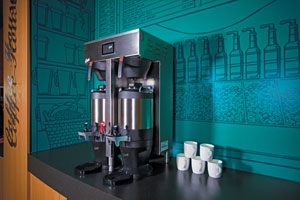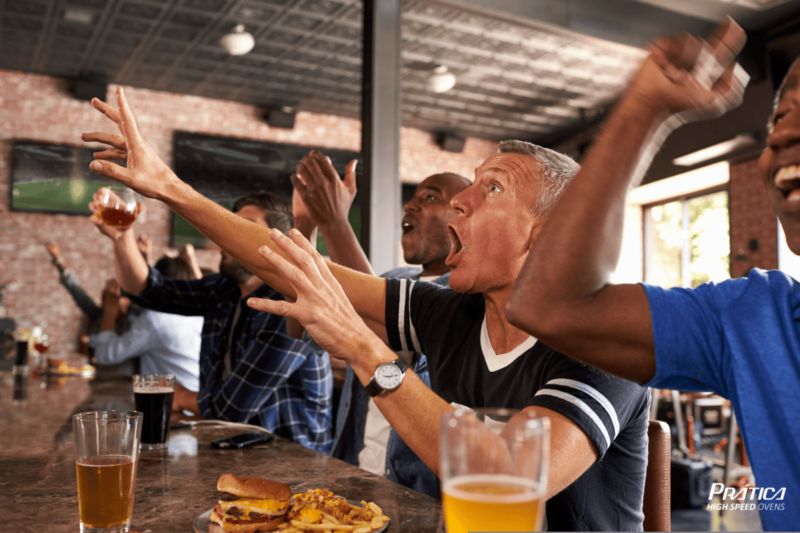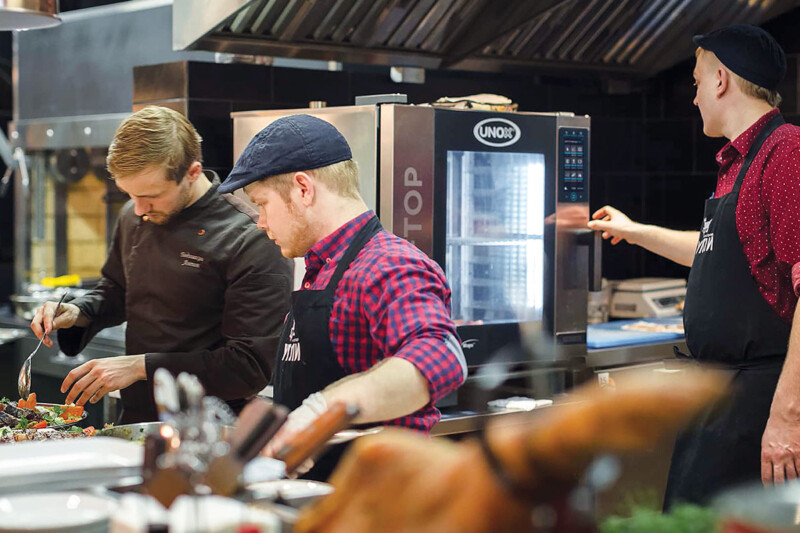Big Brew Ha-Ha

Coffee is ubiquitous. A coffeeshop used to be that little place down the street where you could get a 50-cent cup of joe to go with your morning eggs or midday patty melt. Now there are almost as many Starbucks stores as McD’s in the U.S., and everybody, it seems, has an all-day breakfast menu. Coffee’s an all-day drink too, and keeping it fresh all day matters—a lot.
Having a coffeeshop on every corner has fueled, not sated, demand for coffee, and has exposed consumers to a wide variety of specialty coffees and different roasts. Increasingly, when customers ask for a cup of coffee, they expect it to be good, no matter where it’s served. While a four-burner brewer with three carafes of coffee and one with decaf may be enough to keep up in the picturesque place described above, you might need something a little larger and more robust to keep up with the crowds as well as their expectations in your facilities.
Super high-volume operations such as hospitals, hotels and banquet halls may have big urn systems in the back-of-house. But for medium- to high-volume coffee consumption there are a large number of brewers on the market that brew anywhere from one to three gallons per batch, and anywhere from about eight to 36 gallons per hour.
Adjust The Volume
Volume is a good place to start figuring out which system or equipment you need. Take the examples above. A brewer that produces eight gallons per hour gives you the capacity to sell 128 8-oz. cups per hour. But how often do you serve an 8-oz. cup of coffee? A 12-oz. cup is pretty standard fare these days, which means that same brewer can serve about 85 customers.
A 36-gal. capacity sounds like a lot of coffee until you do the math and see that it equals 384 12-oz. servings per hour. Odds are good that there are many venues that do that kind of volume—stadium concessions, super-busy coffeeshops, hotel restaurants and college and corporate serveries, etc. (Smaller carafe brewers that make a half-gallon at a time—or 1 gal. in a twin brewer—may produce enough coffee to serve your customers, but employees could end up brewing batches more frequently and having to watch carafes on burners to make sure coffee doesn’t sit too long and get scorched.)
Base your volume estimates on peak demand. Factor in free refills and customers who want larger servings to go. Take into account what percentage of your customers will ask for decaffeinated coffee. Then consider whether you plan to offer different coffee blends or roasts at the same time—a house blend and a fl avored coffee, for example. You may need extra brewing capacity to fill serving containers with different coffees even if you don’t go through it all during your peak demand.
Hold It Right There
Brewing systems are largely similar. They vary primarily in the degree of sophistication of their controls and the method in which they hold and dispense coffee. In the medium- to high-volume brewer range two hold/serve options predominate—satellite systems and vacuum insulated dispensers.
Satellite systems have been around since the 1980s, and are easily recognized by their cube shape containers meant to be used in remote locations. The insulated satellite containers are designed with a special brew-through lid that helps seal in heat and prevent spills. They are available in heated or unheated versions. Heating stands typically offer low, medium and high heat settings that maintain coffee temperature by pulsing power to the heating element so coffee doesn’t burn or overheat and degrade too quickly. Standard satellite containers, often called shuttles, hold 1½ gallons, but most brewers let you set brew cycles at ½, 1 and 1½ gallons, so you can brew smaller batches and keep coffee fresh.
Your other option, thermal containers/servers, offers a wide range of sizes from 1 to 3 gallons. Smaller versions of these—insulated pour pots and pump-style airpots—typically are paired with smaller brewers or are used in lower-volume self-serve situations. But larger versions handle volume needs. These gravity-fed, double-walled, vacuum containers maintain coffee temperature at 175°F-180°F for about two hours. Because they’re usually paired with a specific brewing system, their dimensions will vary from one manufacturer to another. (One maker, though, just introduced a brewer that’s compatible with almost all of its thermal containers/servers.)
Thermal containers/servers most often are designed with a sight glass that lets you see how much coffee is left inside. Some newer styles, though, have LED displays that alert employees to the amount of coffee in the container.
Keeping track of when to change out servers is another issue. Many operators still do it manually. In coffeeshops such as Starbucks and Tully’s, employees often set timers and hang them on servers. One fast-casual chain’s policy is to change servers every hour, so the brew time is written in grease pen on a sign that’s hung on the server. More servers, though, have digital displays that indicate how long the coffee has been held.
Something’s Brewing
Brewing a good cup of coffee depends primarily on the three “Ts”—time, temperature and turbulence. To extract the right amount of volatile oils and solids from coffee, the coffee grounds need to be exposed to hot water for a certain amount of time. Under-expose the grounds (not enough time, temperature too low, or not enough turbulence in the brew basket), and the coffee will be thin and weak. Overexpose the grounds and the brew will be too bitter and strong.
Ideal brewing temperature may vary from one type of coffee and grind to another, but the sweet spot in most cases is in the range of 198°F-202°F. Manufacturers design their spray heads and brew baskets in such a way that the flow of that water through the coffee grounds brews an entire batch in about five minutes. Again, the time may vary depending on the model and the coffee being brewed.
To deliver the three Ts consistently, virtually all brewing equipment will feature pre-wetting or pre-infusion, pulse brew, and a variable bypass to control strength. The pre-infusion feature is a timed delay that allows the coffee grounds to “bloom” after an initial wetting. Once the brew cycle begins, brewers use a pulse brew feature to control flow of water into the grounds and create some additional turbulence. The bypass feature allows the brewer to add water directly into the serving container instead of the brew basket, letting you control how strong the coffee tastes.
If that makes it sound like brewers are pretty much the same, they are in basic respects. Where they differ from one maker to another, and even one manufacturer’s model to another, is the degree and type of control you have over the brewer and the brewing process.
Get With The Program
Brewers in this segment have varying levels of sophistication. The most basic models are electromechanical with little more than an on-off switch and ready light. A step up are digital controls either with buttons or touch pads that enable you to do more with the brewer. The most sophisticated brewers feature touchscreens, and are fully programmable (though they usually come with some pre-set programs).
Why would you want a brewer you can program? “We looked for ease of changing programs when evaluating brewers, for sure,” says the director of engineering at one sandwich chain. “We don’t often change the brewing cycle, but we did change the pack size and having a brewer that is easily programmable was helpful.”
The types of parameters you can program—and should look for in a programmable model—include brew volume (so you can brew half a batch, for example); brew time (to accommodate a specific roast or grind); pre-infusion percentage (the amount of water in the brew cycle you want to use to pre-wet the grounds); pre-infusions delay (how much time you want the coffee grounds to bloom before brewing begins); drip delay (the amount of time you want to pass after all the water has been dispensed into the brew basket and the end-of-cycle signal so the coffee has time to flow through the filter into the container); and bypass percentage (the percentage of the water in the batch you want to go directly into the serving container, bypassing the brew basket).
Programmable brewers usually also have a USB port or SD memory card slot that let you plug in a thumb drive and download recipes to the brewer when you change coffee roasts or flavors. Menu changes are a snap, and consistency from store to store assured.
More sophisticated controls also give you self-diagnostics that can alert employees to operating issues, as well as inform managers when it’s time to clean or service the brewer. All of which adds to the life of the brewer. Look for a battery back-up feature that protects programs in memory, settings and clock time/date in the event of a power outage.
Vive La Difference!
Other differences you’ll find among makes and models include brew-basket and spray-head design. Most spray heads resemble showerheads, and are designed to spread hot water evenly across the entire diameter of the brew basket. One maker has designed the head for its brewers more like a cascading fountain. The advantage is it has no holes that might get clogged with mineral deposits and it’s easier to clean. Each maker, though, pairs its spray head and brew basket to provide the necessary flow rate to produce a great cup of coffee.
Other differences worth looking into as you compare brewers are water-tank size and recovery time. Since brew time won’t be any faster from one machine to the next, the key to volume production is how much hot water the brewer has in reserve for the next batch, and how quickly the water temperature recovers as the tank refills. As an example, one maker’s high-volume twin brewer with 3-gal. servers has an 8.7-gal. tank, and brews 30 gallons of coffee per hour. Another manufacturer’s comparable brewer has a 14.5-gal. tank, which it claims enables the brewer to produce 36 gallons of coffee per hour.
A large tank and fast recovery are important in another way. Most large brewers have a hot water faucet that lets employees make cups of tea, hot chocolate or other hot beverages. You need enough hot water in the tank to meet your peak coffee demand while providing hot water for other beverages at the same time. Consider placement of the hot water faucet and flow rate. If you want to fill airpots or serving containers with hot water for tea at a self-serve station, the faucet should be situated high enough to accommodate them. And look for a dispense rate of about 1.3 gal. per minute for fast service.
Most brewers these days are pretty energy efficient, but be sure to look for models with an energy-saving mode that automatically dials down the heating element when the brewer has been idle for a while.
Neat Add-Ons
For convenience, you can purchase coffee in pre-measured filter packs, or buy it ground and measure it into filter cones. But with more of you serving up signature roasts or blends, you might want to grind your own coffee. While there are brewers on the market with integrated grinders, manufacturers don’t recommend them in high-volume operations. First, since the grinder is situated on top of the brewer, adding it on top of a large brewer makes it difficult to replenish. Second, if the grinder goes down for any reason, it puts your brewer out of operation, too.
Instead, makers recommend separate grinders that are paired with the brewing equipment, i.e., sized to fit. At least one manufacturer can upgrade its grinders with an RFID chip that essentially enables the grinder to communicate with the brewer and automatically program its brew cycle.
Also just introduced is a WiFi add-on to thermal servers that let you access information on how much coffee is left in each of your servers and how long it’s been held through an app on your smartphone.
Finally, a couple of manufacturers recently introduced single brewers that can easily shift back and forth between coffee and hot or iced tea. Twin brewer models also are available so you can brew both coffee and tea at the same time. The units come in a slim footprint so they can fit into kitchens or service counters where space is at a premium. Street cost on high-volume brewers can run from about $700 for a single 1-gal. brewer to $7,000 for a twin, high-volume combo coffee/tea brewer. Most twin high-volume brewers with digital controls will run you between $1,200 and $2,300 depending on size and bells and whistles.
Volume Brewer Gallery:
AMERICAN METAL WARE BY GMCW PBIC-430
Model PBIC-430 is versatile; brews into 1½-gal. air-insulated shuttles, 1½-gal. vacuum-insulated shuttles or 3-liter airpots. Shuttles are portable and will maintain hot, freshly brewed coffee without additional heat. The unit is digitally controlled with PrecisionBrew Technology. The brewer will hold the brew temperature to +/- 1°F during the complete brew cycle. Many brew variables are programmable: water temperature, brew volume, pulse brewing sequence, bypass percentage, low temp/no brew, drip time, pre-infusion and lockout, along with an energy-saving sleep mode. Brewer measures 36-in.W x 28-in.D x 22-in.H. Gourmet brew basket included.
gmcw.com
BLOOMFIELD 8790-TF
Bloomfield offers a value proposition with simple electro-mechanical controls on its best-selling 8790-TF volume brewer. Its premium stainless thermostat has a full-length sensing bulb that accurately measures water temperature ensuring a quality brew and keeping the tank heater from cycling too frequently. A liquid level sensor and brew valve perform consistently with low or fluctuating water pressures (anywhere between 20-80 psi) And 2 brewing cycles allow you to brew 1- or 1½-gal. batches to accommodate fluctuations in demand. Unit measures 21 3/8-in.W x 18-in.D x 35½-in.H.
wellsbloomfield.com
BUNN INFUSION SERIES
BUNN’s Infusion Series batch brewers offer a distinctive, refined look that’s ideal for front-of-house use as well as back-of-house. Brew basket, dispenser faucet and hot water faucet create intuitive visual cues for users while the bright-blue, LED-light indicators prominently show unit is operational. Quality-in-the-Cup BUNN Infusion Series technology allows for multiple recipes from 1 footprint (167/10-in.W x 221/3-in.D x 324/5-in.H) with 6 brew buttons and 3 batch sizes: ½ gal., 1 gal or 1½ gal. Exclusive Peak Extraction Sprayhead is multi-directional with a 21-hole design to ensure ultimate uniformity of extraction. Unit features a well-positioned fast-flow hot water faucet to provide a greater cup clearance and has a USB port for foolproof programming. Portable Soft Heat servers can alert staff when freshness has expired or server is empty.
bunn.com
CURTIS THERMOPRO G4
This Generation Four (G4) Twin Brewing System features a digital control with a 4 1/3-in. touchscreen. Icon-driven interface streamlines and simplifies operation with easy-to-follow on-screen instructions; enables fast, intuitive training. Built-in self-diagnostic system delivers real-time feedback of the brewing process and energy-saving mode. The unit’s digital Control Module provides precise control over all aspects of brewing: time, temperature and volume, plus specialty-coffee needs from pre-infusion to pulse-brewing to water bypass. Encapsulated control board is resistant to steam, water and impact. Unit comes with pre-set, 1-touch Global Recipes which deliver the perfect brew based on coffee type, grind and weight. Simplifies profile setting for gourmet results every time. The spray head is a patented, mineral-tolerant design that delivers fast wetting. The stainless ThermoPro vacuum-sealed servers keep coffee fresh, hot and flavorful. Unit is 201/8-in.W x 202/3-in.D x 351/8-in.H.
wilburcurtis.com
FETCO CBS-2152XTS
Part of FETCO’s XTS series, the CBS-2152XTS twin 1½-gal. brewer provides flexibility in medium- to high-volume restaurants, cafeterias and banquet halls. Intuitive touchscreen controls create and display individual recipe names for quick and easy access to and brewing of your most used coffee blends. FETCO’s unique cascading spray dome prevents lime build-up; water flows over the outer surface of the dome instead of through tiny drain holes that easily can become clogged with scale over time. The CSD virtually eliminates spray head scale buildup and ensures consistent brewing, batch after batch. Unit brews into portable Luxus thermal servers, which turn virtually any remote location into a hot beverage service station. Other brewers in the series have capacity up to 60 gal./hr. Unit measures 213/4-in.W x 223/4-in.D x 363/4-in.H.
fetco.com
RELATED CONTENT
- Advertisement -
- Advertisement -
- Advertisement -
TRENDING NOW
- Advertisement -
- Advertisement -
- Advertisement -


